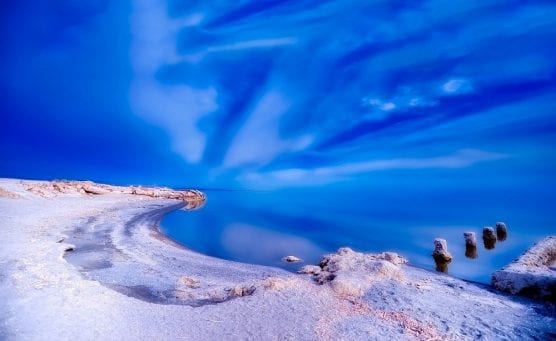By Matthew Renda
A major Southern California water purveyor paved the way Tuesday for a massive restoration project at the Salton Sea in an attempt to stave off ecological devastation and an unfolding public health disaster.
The Imperial Irrigation District, which serves the Imperial Valley in southeastern Southern California, approved an easement agreement with the state on Tuesday that allows the state to begin a critical restoration project at the Salton Sea.
“It is time to get to work,” said Pablo Garza, California political director of ecosystems for the Environmental Defense Fund, in a statement Tuesday. “The communities living near and the wildlife dependent upon the Salton Sea can wait no longer for shovels to hit the ground.”
The Salton Sea is a shallow and salty lake inland of Los Angeles and south of Palm Springs that was created by an overflow of the Colorado River in the early 20th century. It was a resort destination in the 1950s and ’60s before the ecosystem collapsed due to dry conditions, a lack of drainage and pollution.
Today, however, the lake functions as an important stop for a vast array of migratory birds who make their way between the Americas seasonally every year.
Frank Ruiz, Salton Sea program director for Audubon California, said in a statement that hundreds of species rely on the lake.
As prolonged drought has afflicted the Colorado River Basin, and an increasing number of residents rely on run-off that originates in the snowpack of the Rocky Mountains, there is less water for the Salton Sea. Waters are receding, killing fish and causing birds to abandon the lake.
Humans are also feeling the effects of this environmental crisis.
As the waters recede, layers of desert floor – called playa – are exposed, which dries up and creates large amounts of dust kicked up by the winds that pervade the area.
Dust suppression is at the center of the restoration project approved by Imperial Irrigation District directors Tuesday. Plans call for the state to partner with the district to construct a series of ponds over 3,700 acres to serve as a buffer between the Salton Sea and farms to the south.
Habitat restoration is also part of the proposed project that environmentalists say is long overdue.
“Political will had long been the missing piece at the Salton Sea – I’m hopeful that this agreement marks a real turning point,” Pacific Institute researcher Michael Cohen said in a statement.
Cohen and others are skeptical, however, that the latest restoration project is sufficient to prevent the impending ecological and public health disaster.
The Imperial Irrigation District was the only one out of nine water districts to refuse to sign off on the drought contingency plan recently passed by Congress and signed into law by President Donald Trump.
The plan calls for mandatory cutbacks in water delivery to all seven states that siphon water from the Colorado River: Wyoming, Colorado, Utah, New Mexico, Arizona, Nevada and California.
The Imperial district refused to sign on because its demands to provide water for the Salton Sea were ignored. The district has since filed a lawsuit in state court claiming that the contingency plan’s lack of consideration for Salton Sea is a violation of the California Environmental Quality Act.
Like this:
Like Loading...
Related





 Tweet This
Tweet This Facebook
Facebook Digg This
Digg This Bookmark
Bookmark Stumble
Stumble RSS
RSS


























REAL NAMES ONLY: All posters must use their real individual or business name. This applies equally to Twitter account holders who use a nickname.
0 Comments
You can be the first one to leave a comment.